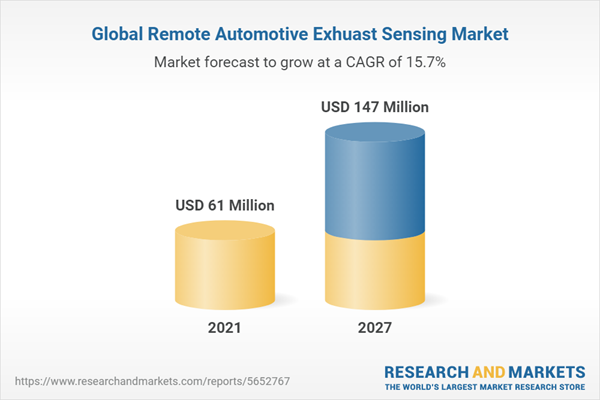The global remote automotive exhaust sensing market was valued at USD 61 million in 2021 and is projected to reach USD 147 million by 2027, registering a CAGR of 15.78% during the forecast period. The rise in demand for remote automotive exhaust sensing systems is also attributed to increasing government environmental policy windows are opening for wider adoption of zero-emission light-duty and heavy-duty vehicles and awareness among consumers about air pollution caused by combustion of fuels in vehicles.
Services Offering: The segment expected to account for the largest share of remote automotive exhaust sensing market by 2027
The services segment is expected to account for the largest market share (~62%) in 2027. The companies offer their remote automotive exhaust sensing system for rent/lease for these collaborations. For instance, in September 2020, Opus Group AB (Opus RSE), as a part of the TRUE initiative, launched a vehicle emissions testing program in Warsaw, Poland. Under this program, data for real-world NOx emissions of 150,000 vehicles will be monitored. Also, the effectiveness of the Euro 6d regulation at controlling real-world emissions of vehicles will be tested. For monitoring vehicles, Opus RSD5000 was used on a rental base. The system rent and charges for the data are based on the number of vehicles scanned by the remote sensing device. Together, these features are expected to drive the market growth for services offering.
RoW: To grow at second highest CAGR in 2027
RoW is expected to grow at highest CAGR of 15.6% of the remote automotive exhaust sensing market in 2027. The governments of the regions are taking the utmost initiative to enhance the air quality by measuring exhaust pollutants from vehicles. The Environment Agency Abu Dhabi (EAD) has initiated this process and is expected to start in winter 2022. Moreover, the Dubai Roads & Transport Authority (RTA) and Dubai Police have carried out a similar initiative to vehicle emission survey to measure on-road emissions. The Iran government has taken initiatives and deployed a crossroad remote sensing system to measure vehicle pollutants from passenger cars, light commercial vehicles such as vans and pickup trucks, and heavy-duty vehicles. The growing initiatives by governments in the Middle East & Africa region are expected to spur the growth of the remote automotive exhaust sensing market in the near future in the region.
Breakdown of primaries
The study contains insights from various industry experts, ranging from component suppliers to Tier 1 companies and OEMs. The break-up of the primaries is as follows:
- By Designation - C level - 40%, Managers - 30%, Other Level - 30%
- By Region - North America - 40%, Asia Pacific - 35%, Europe - 15%, RoW - 10%,
The remote automotive exhaust sensing market is dominated by a few globally established players such as Opus Group AB (Sweden), Hager Environmental & Atmospheric Technologies (US), Doppler Environmental Protection Technology Co., Ltd. (China), Anhui Baolong Environmental Protection Technology Co., Ltd. (China), Korea Environment Corporation (South Korea), and Hangzhou Chunlai Technology Co., Ltd. (China). The study includes an in-depth competitive analysis of these key players in the remote automotive exhaust sensing market, with their company profiles, recent developments, and key market strategies.
Research Coverage:
The report segments the remote automotive exhaust sensing market and forecasts its size, by value, based on region (Asia Pacific, Europe, North America, and RoW), offering (Hardware, Software, Services). The report also provides a comprehensive review of market drivers, restraints, opportunities, and challenges in the remote automotive exhaust sensing market. The report also covers qualitative aspects for fuel type (Petrol, Diesel) and types of pollutant (Carbon Monoxide, Carbon Dioxide, Nitrogen Oxide, Hydrocarbon, Particulate Matter)segments of the market.
Key Benefits of Buying the Report:
The report will help the leaders/new entrants in this market with information on the closest approximations of the revenue numbers for the overall market and the sub-segments. This report will help stakeholders understand the competitive landscape and gain more insights to better position their businesses and plan suitable go-to-market strategies. The report also helps stakeholders understand the pulse of theremote automotive exhaust sensingmarket and provides them information on key market drivers, restraints, challenges, and opportunities.
Table of Contents
Companies Mentioned
- Anhui Baolong Environmental Protection Technology Co., Ltd.
- California Air Resources Board (Carb)
- Doppler Environmental Protection Technology Co., Ltd.
- Hager Environmental & Atmospheric Technologies (Heat)
- Hangzhou Chunlai Technology Co., Ltd.
- Korea Environment Corporation (K-Eco)
- Opus Group Ab
- University of Denver
Methodology

LOADING...
Table Information
| Report Attribute | Details |
|---|---|
| No. of Pages | 119 |
| Published | August 2022 |
| Forecast Period | 2021 - 2027 |
| Estimated Market Value ( USD | $ 61 Million |
| Forecasted Market Value ( USD | $ 147 Million |
| Compound Annual Growth Rate | 15.7% |
| Regions Covered | Global |
| No. of Companies Mentioned | 8 |









